ISY2005 Report: Enterprise Systems' Impact on Organizational Growth
VerifiedAdded on 2023/06/15
|8
|2119
|438
Report
AI Summary
This report examines the role of enterprise systems in enhancing organizational performance, focusing on how these systems integrate business processes and improve resource planning. It discusses the contributions of enterprise systems, highlighting their impact on organizational culture, decision-making, and business process efficiency. The report also explores the drivers behind the adoption of supply chain management (SCM) systems, including improved operations, contract management, and risk mitigation. Furthermore, it addresses the organizational change management considerations necessary for the successful implementation of enterprise systems, such as communication strategies, employee engagement, training, and leadership. The report concludes that enterprise systems significantly improve organizational effectiveness and efficiency, measurable through profits, customer retention, and assessment models.

RUNNING HEAD: Enterprise Systems
Enterprise Systems
Enterprise Systems
Paraphrase This Document
Need a fresh take? Get an instant paraphrase of this document with our AI Paraphraser
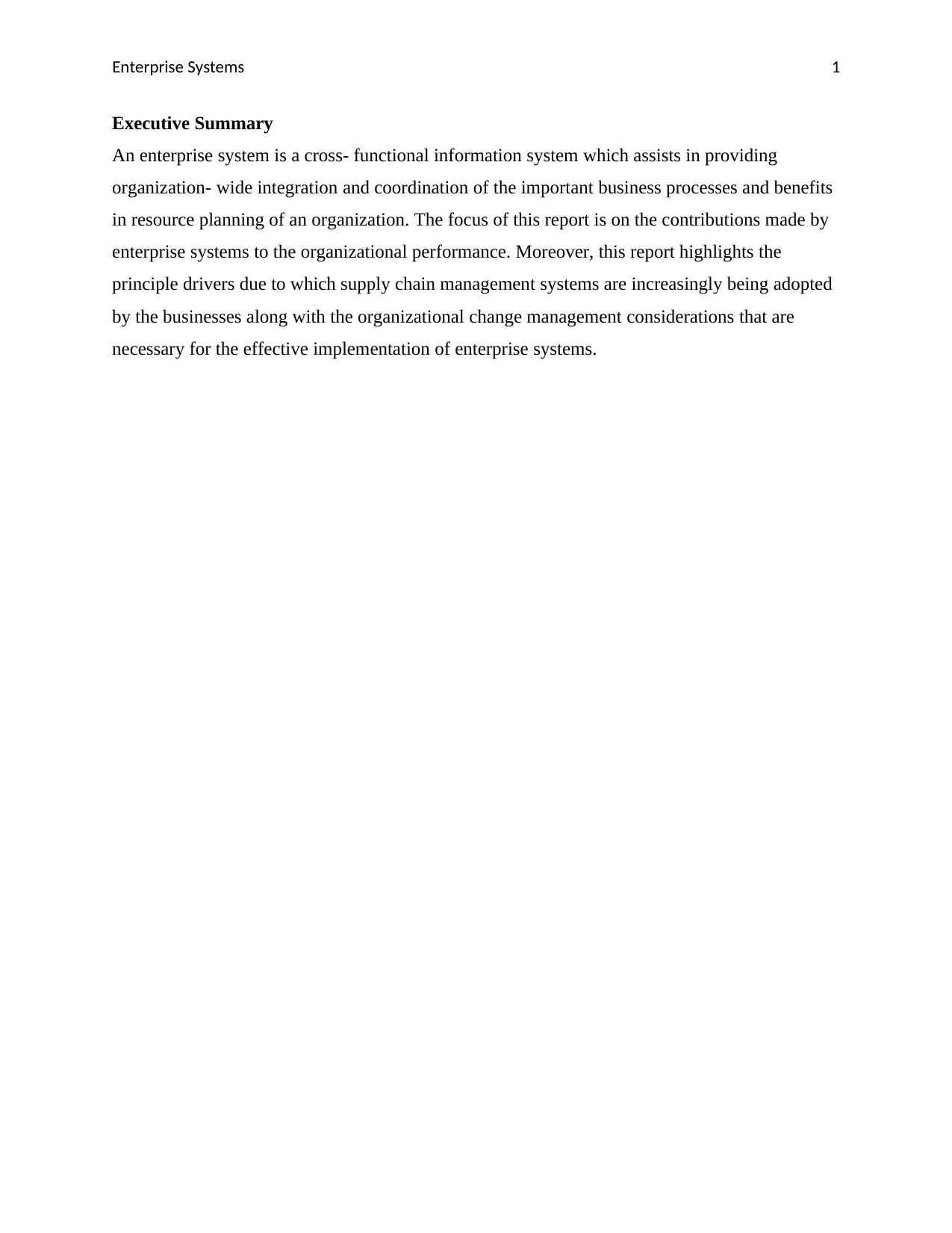
Enterprise Systems 1
Executive Summary
An enterprise system is a cross- functional information system which assists in providing
organization- wide integration and coordination of the important business processes and benefits
in resource planning of an organization. The focus of this report is on the contributions made by
enterprise systems to the organizational performance. Moreover, this report highlights the
principle drivers due to which supply chain management systems are increasingly being adopted
by the businesses along with the organizational change management considerations that are
necessary for the effective implementation of enterprise systems.
Executive Summary
An enterprise system is a cross- functional information system which assists in providing
organization- wide integration and coordination of the important business processes and benefits
in resource planning of an organization. The focus of this report is on the contributions made by
enterprise systems to the organizational performance. Moreover, this report highlights the
principle drivers due to which supply chain management systems are increasingly being adopted
by the businesses along with the organizational change management considerations that are
necessary for the effective implementation of enterprise systems.
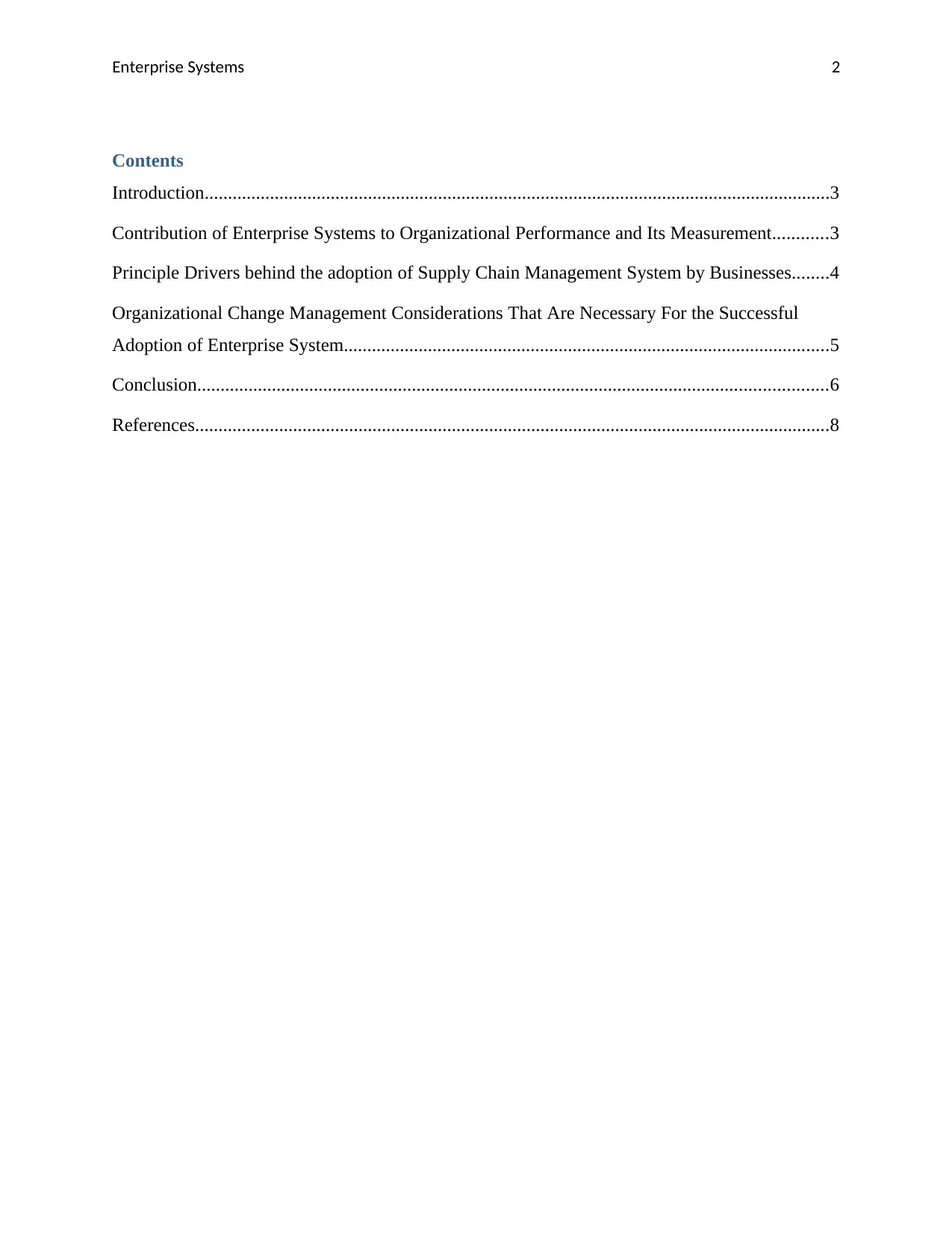
Enterprise Systems 2
Contents
Introduction......................................................................................................................................3
Contribution of Enterprise Systems to Organizational Performance and Its Measurement............3
Principle Drivers behind the adoption of Supply Chain Management System by Businesses........4
Organizational Change Management Considerations That Are Necessary For the Successful
Adoption of Enterprise System........................................................................................................5
Conclusion.......................................................................................................................................6
References........................................................................................................................................8
Contents
Introduction......................................................................................................................................3
Contribution of Enterprise Systems to Organizational Performance and Its Measurement............3
Principle Drivers behind the adoption of Supply Chain Management System by Businesses........4
Organizational Change Management Considerations That Are Necessary For the Successful
Adoption of Enterprise System........................................................................................................5
Conclusion.......................................................................................................................................6
References........................................................................................................................................8
⊘ This is a preview!⊘
Do you want full access?
Subscribe today to unlock all pages.

Trusted by 1+ million students worldwide
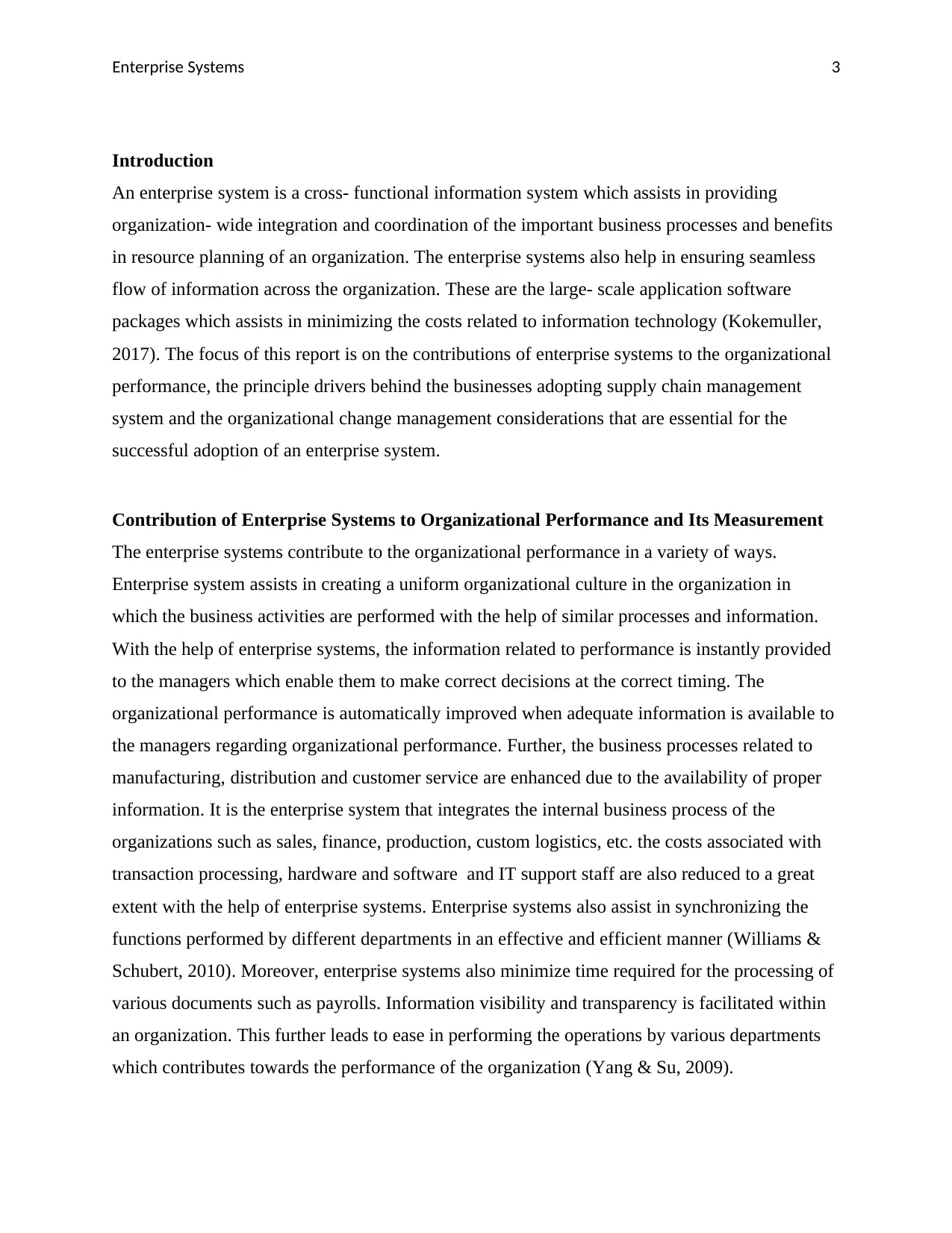
Enterprise Systems 3
Introduction
An enterprise system is a cross- functional information system which assists in providing
organization- wide integration and coordination of the important business processes and benefits
in resource planning of an organization. The enterprise systems also help in ensuring seamless
flow of information across the organization. These are the large- scale application software
packages which assists in minimizing the costs related to information technology (Kokemuller,
2017). The focus of this report is on the contributions of enterprise systems to the organizational
performance, the principle drivers behind the businesses adopting supply chain management
system and the organizational change management considerations that are essential for the
successful adoption of an enterprise system.
Contribution of Enterprise Systems to Organizational Performance and Its Measurement
The enterprise systems contribute to the organizational performance in a variety of ways.
Enterprise system assists in creating a uniform organizational culture in the organization in
which the business activities are performed with the help of similar processes and information.
With the help of enterprise systems, the information related to performance is instantly provided
to the managers which enable them to make correct decisions at the correct timing. The
organizational performance is automatically improved when adequate information is available to
the managers regarding organizational performance. Further, the business processes related to
manufacturing, distribution and customer service are enhanced due to the availability of proper
information. It is the enterprise system that integrates the internal business process of the
organizations such as sales, finance, production, custom logistics, etc. the costs associated with
transaction processing, hardware and software and IT support staff are also reduced to a great
extent with the help of enterprise systems. Enterprise systems also assist in synchronizing the
functions performed by different departments in an effective and efficient manner (Williams &
Schubert, 2010). Moreover, enterprise systems also minimize time required for the processing of
various documents such as payrolls. Information visibility and transparency is facilitated within
an organization. This further leads to ease in performing the operations by various departments
which contributes towards the performance of the organization (Yang & Su, 2009).
Introduction
An enterprise system is a cross- functional information system which assists in providing
organization- wide integration and coordination of the important business processes and benefits
in resource planning of an organization. The enterprise systems also help in ensuring seamless
flow of information across the organization. These are the large- scale application software
packages which assists in minimizing the costs related to information technology (Kokemuller,
2017). The focus of this report is on the contributions of enterprise systems to the organizational
performance, the principle drivers behind the businesses adopting supply chain management
system and the organizational change management considerations that are essential for the
successful adoption of an enterprise system.
Contribution of Enterprise Systems to Organizational Performance and Its Measurement
The enterprise systems contribute to the organizational performance in a variety of ways.
Enterprise system assists in creating a uniform organizational culture in the organization in
which the business activities are performed with the help of similar processes and information.
With the help of enterprise systems, the information related to performance is instantly provided
to the managers which enable them to make correct decisions at the correct timing. The
organizational performance is automatically improved when adequate information is available to
the managers regarding organizational performance. Further, the business processes related to
manufacturing, distribution and customer service are enhanced due to the availability of proper
information. It is the enterprise system that integrates the internal business process of the
organizations such as sales, finance, production, custom logistics, etc. the costs associated with
transaction processing, hardware and software and IT support staff are also reduced to a great
extent with the help of enterprise systems. Enterprise systems also assist in synchronizing the
functions performed by different departments in an effective and efficient manner (Williams &
Schubert, 2010). Moreover, enterprise systems also minimize time required for the processing of
various documents such as payrolls. Information visibility and transparency is facilitated within
an organization. This further leads to ease in performing the operations by various departments
which contributes towards the performance of the organization (Yang & Su, 2009).
Paraphrase This Document
Need a fresh take? Get an instant paraphrase of this document with our AI Paraphraser

Enterprise Systems 4
However, the contributions made by the enterprise systems are difficult to measure. Still the
contributions are visible in the form of better performance as compared to the competitors,
increased sales, higher sales conversation and customer retention rates and better image of the
organization in the public. Furthermore, with the help of enterprise systems, the organization
acquires the capability to deal with the changing condition in an effective and flexible manner.
The assessment of such contribution can be made with the help of models such as priori model
which makes the use of five separate dimensions of success such as individual impact, system
quality, satisfaction, information quality and organizational impact. Revised model can also be
utilized for the purpose of measuring the contribution of enterprise systems to organizational
performance. The progress of the organization is measured by such model by measuring the
impact of enterprise system in four dimensions namely information quality, organizational
impact, system quality and individual impact.
Principle Drivers behind the adoption of Supply Chain Management System by Businesses
Supply chain management systems are being increasingly adopted by the businesses. Suppliers
have attained greater importance in the organizations. Procurement is essential for businesses at
every aspect which has subsequently increased the reliance of businesses on the suppliers (Monk
& Wagner, 2012). Supply chain management is useful for the purpose of effectively managing
information, contracts, supplier relations and other applicable regulations. Supply chain
management process is effectively established by a supply chain management system which in
turn assists in deriving the optimum value from the expenses made by business through the
analysis of suppliers relating to cost, risk and performance. Therefore, there are various principle
drivers behind the adoption of supply chain management systems by businesses.
Operations are improved with the help of quality techniques that are incorporated with the supply
chain management system which in turn acts as a driver for adopting the system. Contractual
obligations are effectively managed by supply chain management system which subsequently
helps in maintaining continuous supply and avoiding delivery disruption. Moreover, the
implementation of supply chain management systems effectively manages the legal liability
which has the possibility of affecting the business. Such system identifies the risk factors in
advance which allow risk mitigation through the application of supply chain methodologies.
However, the contributions made by the enterprise systems are difficult to measure. Still the
contributions are visible in the form of better performance as compared to the competitors,
increased sales, higher sales conversation and customer retention rates and better image of the
organization in the public. Furthermore, with the help of enterprise systems, the organization
acquires the capability to deal with the changing condition in an effective and flexible manner.
The assessment of such contribution can be made with the help of models such as priori model
which makes the use of five separate dimensions of success such as individual impact, system
quality, satisfaction, information quality and organizational impact. Revised model can also be
utilized for the purpose of measuring the contribution of enterprise systems to organizational
performance. The progress of the organization is measured by such model by measuring the
impact of enterprise system in four dimensions namely information quality, organizational
impact, system quality and individual impact.
Principle Drivers behind the adoption of Supply Chain Management System by Businesses
Supply chain management systems are being increasingly adopted by the businesses. Suppliers
have attained greater importance in the organizations. Procurement is essential for businesses at
every aspect which has subsequently increased the reliance of businesses on the suppliers (Monk
& Wagner, 2012). Supply chain management is useful for the purpose of effectively managing
information, contracts, supplier relations and other applicable regulations. Supply chain
management process is effectively established by a supply chain management system which in
turn assists in deriving the optimum value from the expenses made by business through the
analysis of suppliers relating to cost, risk and performance. Therefore, there are various principle
drivers behind the adoption of supply chain management systems by businesses.
Operations are improved with the help of quality techniques that are incorporated with the supply
chain management system which in turn acts as a driver for adopting the system. Contractual
obligations are effectively managed by supply chain management system which subsequently
helps in maintaining continuous supply and avoiding delivery disruption. Moreover, the
implementation of supply chain management systems effectively manages the legal liability
which has the possibility of affecting the business. Such system identifies the risk factors in
advance which allow risk mitigation through the application of supply chain methodologies.
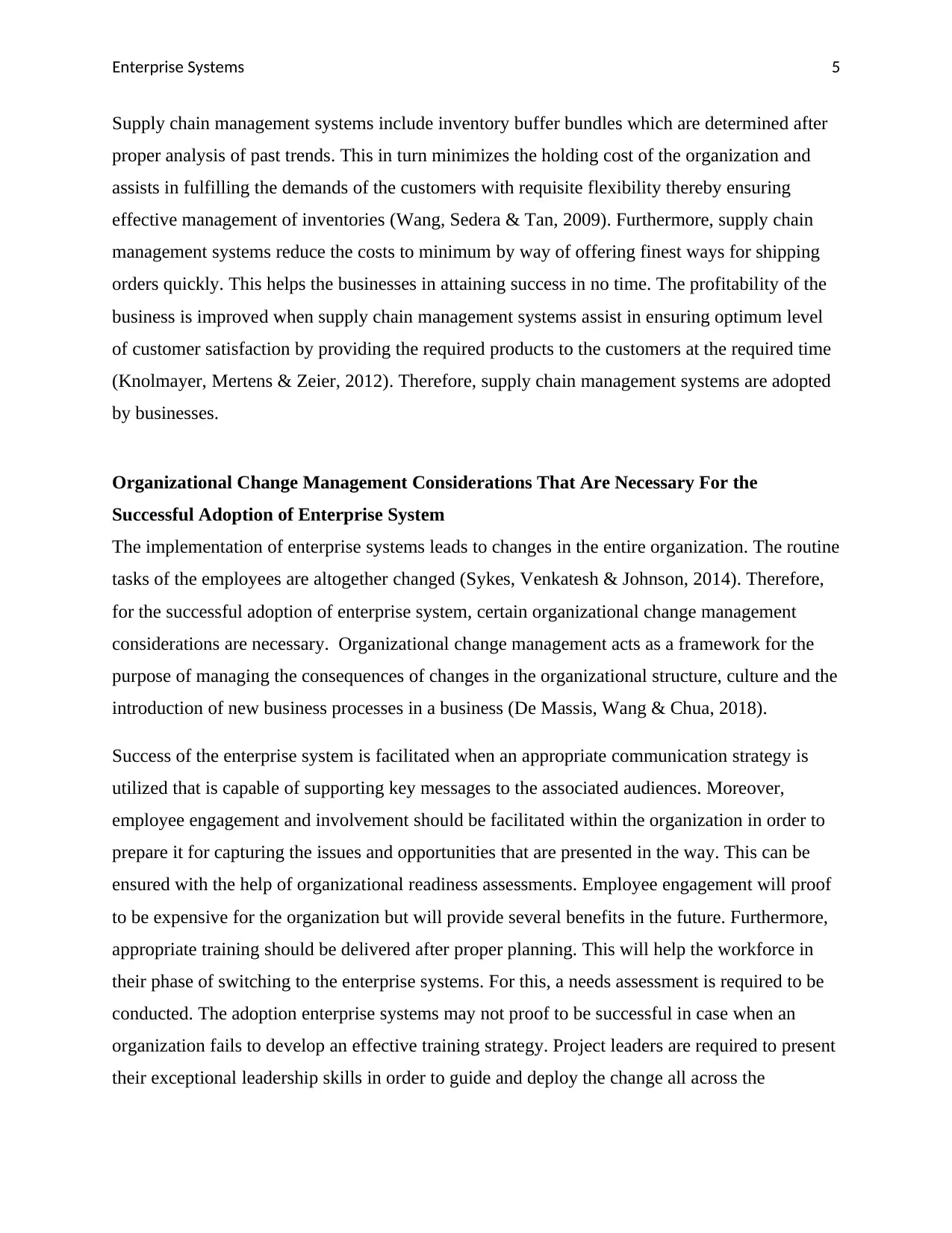
Enterprise Systems 5
Supply chain management systems include inventory buffer bundles which are determined after
proper analysis of past trends. This in turn minimizes the holding cost of the organization and
assists in fulfilling the demands of the customers with requisite flexibility thereby ensuring
effective management of inventories (Wang, Sedera & Tan, 2009). Furthermore, supply chain
management systems reduce the costs to minimum by way of offering finest ways for shipping
orders quickly. This helps the businesses in attaining success in no time. The profitability of the
business is improved when supply chain management systems assist in ensuring optimum level
of customer satisfaction by providing the required products to the customers at the required time
(Knolmayer, Mertens & Zeier, 2012). Therefore, supply chain management systems are adopted
by businesses.
Organizational Change Management Considerations That Are Necessary For the
Successful Adoption of Enterprise System
The implementation of enterprise systems leads to changes in the entire organization. The routine
tasks of the employees are altogether changed (Sykes, Venkatesh & Johnson, 2014). Therefore,
for the successful adoption of enterprise system, certain organizational change management
considerations are necessary. Organizational change management acts as a framework for the
purpose of managing the consequences of changes in the organizational structure, culture and the
introduction of new business processes in a business (De Massis, Wang & Chua, 2018).
Success of the enterprise system is facilitated when an appropriate communication strategy is
utilized that is capable of supporting key messages to the associated audiences. Moreover,
employee engagement and involvement should be facilitated within the organization in order to
prepare it for capturing the issues and opportunities that are presented in the way. This can be
ensured with the help of organizational readiness assessments. Employee engagement will proof
to be expensive for the organization but will provide several benefits in the future. Furthermore,
appropriate training should be delivered after proper planning. This will help the workforce in
their phase of switching to the enterprise systems. For this, a needs assessment is required to be
conducted. The adoption enterprise systems may not proof to be successful in case when an
organization fails to develop an effective training strategy. Project leaders are required to present
their exceptional leadership skills in order to guide and deploy the change all across the
Supply chain management systems include inventory buffer bundles which are determined after
proper analysis of past trends. This in turn minimizes the holding cost of the organization and
assists in fulfilling the demands of the customers with requisite flexibility thereby ensuring
effective management of inventories (Wang, Sedera & Tan, 2009). Furthermore, supply chain
management systems reduce the costs to minimum by way of offering finest ways for shipping
orders quickly. This helps the businesses in attaining success in no time. The profitability of the
business is improved when supply chain management systems assist in ensuring optimum level
of customer satisfaction by providing the required products to the customers at the required time
(Knolmayer, Mertens & Zeier, 2012). Therefore, supply chain management systems are adopted
by businesses.
Organizational Change Management Considerations That Are Necessary For the
Successful Adoption of Enterprise System
The implementation of enterprise systems leads to changes in the entire organization. The routine
tasks of the employees are altogether changed (Sykes, Venkatesh & Johnson, 2014). Therefore,
for the successful adoption of enterprise system, certain organizational change management
considerations are necessary. Organizational change management acts as a framework for the
purpose of managing the consequences of changes in the organizational structure, culture and the
introduction of new business processes in a business (De Massis, Wang & Chua, 2018).
Success of the enterprise system is facilitated when an appropriate communication strategy is
utilized that is capable of supporting key messages to the associated audiences. Moreover,
employee engagement and involvement should be facilitated within the organization in order to
prepare it for capturing the issues and opportunities that are presented in the way. This can be
ensured with the help of organizational readiness assessments. Employee engagement will proof
to be expensive for the organization but will provide several benefits in the future. Furthermore,
appropriate training should be delivered after proper planning. This will help the workforce in
their phase of switching to the enterprise systems. For this, a needs assessment is required to be
conducted. The adoption enterprise systems may not proof to be successful in case when an
organization fails to develop an effective training strategy. Project leaders are required to present
their exceptional leadership skills in order to guide and deploy the change all across the
⊘ This is a preview!⊘
Do you want full access?
Subscribe today to unlock all pages.

Trusted by 1+ million students worldwide

Enterprise Systems 6
organization. The adaptive work can be effectively performed by people if they are provided
proper leadership (Sedera,Gronau & Sumner, 2015).
Organizational change management considerations to be kept in mind also include various other
factors. The risks and opportunity to which an organization is exposed should be assessed and
managed on time by way of formulating plans that suggests actions required to be taken. This
must also involve the ways with the help of which opportunities can be maximized and risk can
be minimized while managing change in the organization (Mattiske, 2012). Stakeholders should
be involved in the process with the help of a communication plan which facilitates the
communication of required information at the correct timing (Kumar, Loonam, Allen & Sawyer,
2016). A guiding union should be formulated for leaders that support a shared vision. The
leaders will be responsible for the preparation of terms of priorities, resources and adjusted goals
for their respective areas after properly understanding the change. The organizational structure
should then be planned in a manner such that it supports the anticipated future state of the
organization. The workforce should be properly prepared and equipped as their jobs will get
affected due to the introduction of enterprise systems. Therefore, the workforce must be provided
a training regarding the manner of performing the jobs after enterprise systems.
Conclusion
Therefore, it can be concluded that an enterprise system is a cross- functional information system
which assists in providing organization- wide integration and coordination of the important
business processes and benefits in resource planning of an organization. The effectiveness and
efficiency of organizational performance is significantly improved with the help of enterprise
systems. Such contributions of enterprise systems to organizational performance can be
measured with the help of profits, customer retention rates and various models such as revised
model and priori model. The principle drivers behind the adoption of supply chain management
systems by the businesses have also been highlighted in the report. Moreover, this report also
focused on the necessary organizational change management considerations which assist in
managing the business processes in an effective manner.
organization. The adaptive work can be effectively performed by people if they are provided
proper leadership (Sedera,Gronau & Sumner, 2015).
Organizational change management considerations to be kept in mind also include various other
factors. The risks and opportunity to which an organization is exposed should be assessed and
managed on time by way of formulating plans that suggests actions required to be taken. This
must also involve the ways with the help of which opportunities can be maximized and risk can
be minimized while managing change in the organization (Mattiske, 2012). Stakeholders should
be involved in the process with the help of a communication plan which facilitates the
communication of required information at the correct timing (Kumar, Loonam, Allen & Sawyer,
2016). A guiding union should be formulated for leaders that support a shared vision. The
leaders will be responsible for the preparation of terms of priorities, resources and adjusted goals
for their respective areas after properly understanding the change. The organizational structure
should then be planned in a manner such that it supports the anticipated future state of the
organization. The workforce should be properly prepared and equipped as their jobs will get
affected due to the introduction of enterprise systems. Therefore, the workforce must be provided
a training regarding the manner of performing the jobs after enterprise systems.
Conclusion
Therefore, it can be concluded that an enterprise system is a cross- functional information system
which assists in providing organization- wide integration and coordination of the important
business processes and benefits in resource planning of an organization. The effectiveness and
efficiency of organizational performance is significantly improved with the help of enterprise
systems. Such contributions of enterprise systems to organizational performance can be
measured with the help of profits, customer retention rates and various models such as revised
model and priori model. The principle drivers behind the adoption of supply chain management
systems by the businesses have also been highlighted in the report. Moreover, this report also
focused on the necessary organizational change management considerations which assist in
managing the business processes in an effective manner.
Paraphrase This Document
Need a fresh take? Get an instant paraphrase of this document with our AI Paraphraser
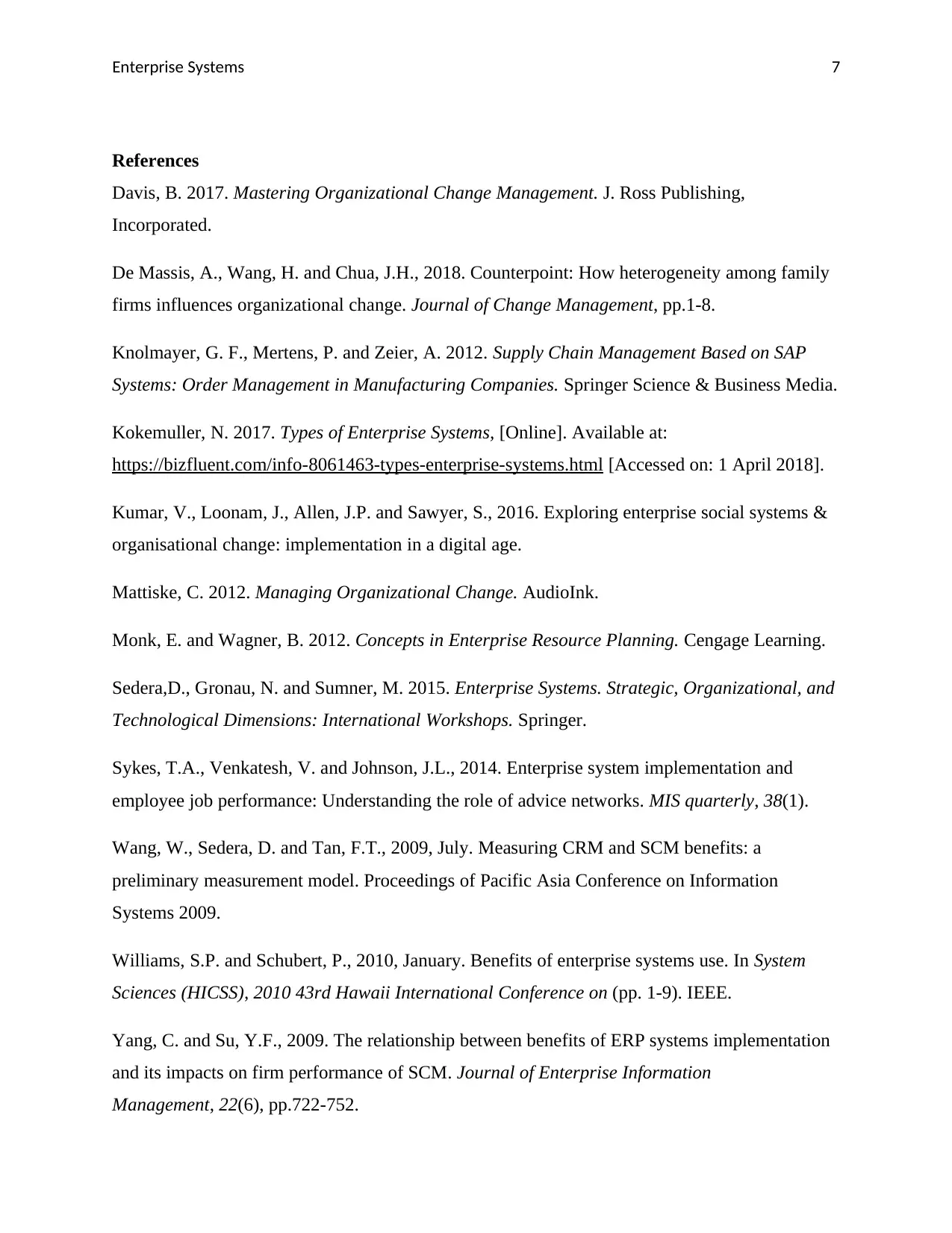
Enterprise Systems 7
References
Davis, B. 2017. Mastering Organizational Change Management. J. Ross Publishing,
Incorporated.
De Massis, A., Wang, H. and Chua, J.H., 2018. Counterpoint: How heterogeneity among family
firms influences organizational change. Journal of Change Management, pp.1-8.
Knolmayer, G. F., Mertens, P. and Zeier, A. 2012. Supply Chain Management Based on SAP
Systems: Order Management in Manufacturing Companies. Springer Science & Business Media.
Kokemuller, N. 2017. Types of Enterprise Systems, [Online]. Available at:
https://bizfluent.com/info-8061463-types-enterprise-systems.html [Accessed on: 1 April 2018].
Kumar, V., Loonam, J., Allen, J.P. and Sawyer, S., 2016. Exploring enterprise social systems &
organisational change: implementation in a digital age.
Mattiske, C. 2012. Managing Organizational Change. AudioInk.
Monk, E. and Wagner, B. 2012. Concepts in Enterprise Resource Planning. Cengage Learning.
Sedera,D., Gronau, N. and Sumner, M. 2015. Enterprise Systems. Strategic, Organizational, and
Technological Dimensions: International Workshops. Springer.
Sykes, T.A., Venkatesh, V. and Johnson, J.L., 2014. Enterprise system implementation and
employee job performance: Understanding the role of advice networks. MIS quarterly, 38(1).
Wang, W., Sedera, D. and Tan, F.T., 2009, July. Measuring CRM and SCM benefits: a
preliminary measurement model. Proceedings of Pacific Asia Conference on Information
Systems 2009.
Williams, S.P. and Schubert, P., 2010, January. Benefits of enterprise systems use. In System
Sciences (HICSS), 2010 43rd Hawaii International Conference on (pp. 1-9). IEEE.
Yang, C. and Su, Y.F., 2009. The relationship between benefits of ERP systems implementation
and its impacts on firm performance of SCM. Journal of Enterprise Information
Management, 22(6), pp.722-752.
References
Davis, B. 2017. Mastering Organizational Change Management. J. Ross Publishing,
Incorporated.
De Massis, A., Wang, H. and Chua, J.H., 2018. Counterpoint: How heterogeneity among family
firms influences organizational change. Journal of Change Management, pp.1-8.
Knolmayer, G. F., Mertens, P. and Zeier, A. 2012. Supply Chain Management Based on SAP
Systems: Order Management in Manufacturing Companies. Springer Science & Business Media.
Kokemuller, N. 2017. Types of Enterprise Systems, [Online]. Available at:
https://bizfluent.com/info-8061463-types-enterprise-systems.html [Accessed on: 1 April 2018].
Kumar, V., Loonam, J., Allen, J.P. and Sawyer, S., 2016. Exploring enterprise social systems &
organisational change: implementation in a digital age.
Mattiske, C. 2012. Managing Organizational Change. AudioInk.
Monk, E. and Wagner, B. 2012. Concepts in Enterprise Resource Planning. Cengage Learning.
Sedera,D., Gronau, N. and Sumner, M. 2015. Enterprise Systems. Strategic, Organizational, and
Technological Dimensions: International Workshops. Springer.
Sykes, T.A., Venkatesh, V. and Johnson, J.L., 2014. Enterprise system implementation and
employee job performance: Understanding the role of advice networks. MIS quarterly, 38(1).
Wang, W., Sedera, D. and Tan, F.T., 2009, July. Measuring CRM and SCM benefits: a
preliminary measurement model. Proceedings of Pacific Asia Conference on Information
Systems 2009.
Williams, S.P. and Schubert, P., 2010, January. Benefits of enterprise systems use. In System
Sciences (HICSS), 2010 43rd Hawaii International Conference on (pp. 1-9). IEEE.
Yang, C. and Su, Y.F., 2009. The relationship between benefits of ERP systems implementation
and its impacts on firm performance of SCM. Journal of Enterprise Information
Management, 22(6), pp.722-752.
1 out of 8
Related Documents
Your All-in-One AI-Powered Toolkit for Academic Success.
+13062052269
info@desklib.com
Available 24*7 on WhatsApp / Email
![[object Object]](/_next/static/media/star-bottom.7253800d.svg)
Unlock your academic potential
Copyright © 2020–2025 A2Z Services. All Rights Reserved. Developed and managed by ZUCOL.





